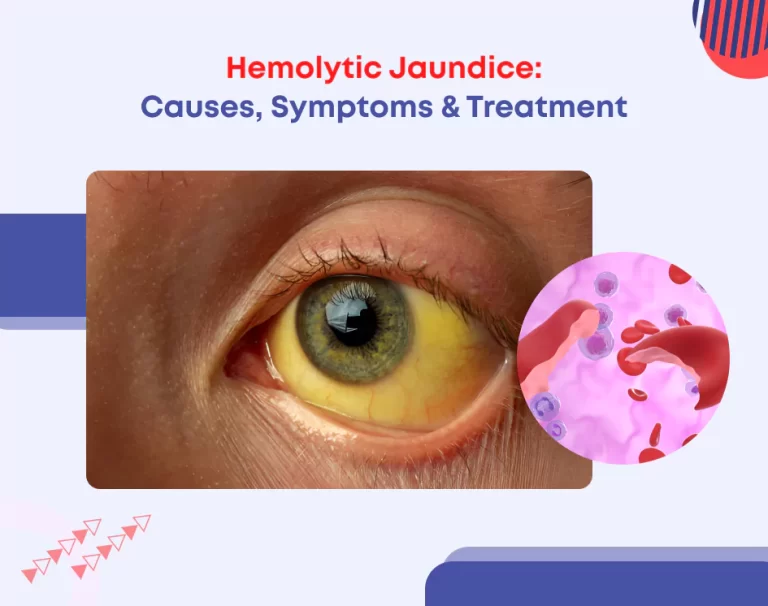
Hemolytic Jaundice: Causes, Symptoms & Treatment
Hemolytic jaundice is a medical condition caused by the breakdown of red blood cells (RBCs), resulting in an excess of bilirubin in the bloodstream. This yellow pigment can lead to noticeable yellowing of the skin and eyes. In this blog post, we’ll explore the causes, symptoms, diagnosis, and treatment options for hemolytic jaundice.
What is Hemolytic Jaundice?
Hemolytic jaundice occurs when the body destroys red blood cells faster than it can produce new ones. The breakdown of these cells releases hemoglobin, which is then converted into bilirubin in the liver. If the liver cannot process this bilirubin quickly enough, it accumulates in the blood, leading to jaundice.
Types of Jaundice
Jaundice is generally classified into three types.
Hemolytic Jaundice: Resulting from the excessive destruction of red blood cells.
Obstructive Jaundice: Happens when there is a blockage in the bile ducts, hindering the excretion of bilirubin.
Hepatocellular Jaundice: Arises from liver damage or disease, affecting the liver’s ability to process bilirubin.
Causes of Hemolytic Jaundice
Several factors can lead to hemolytic jaundice, including:
Autoimmune Disorders
In autoimmune hemolytic anemia, the body’s immune system mistakenly attacks its own red blood cells, leading to increased destruction. Conditions like lupus or rheumatoid arthritis may contribute to this.
Genetic Disorders
Certain inherited conditions, such as sickle cell disease or thalassemia, can cause the body to produce abnormal red blood cells that are more susceptible to destruction.
Infections
Some infections, such as malaria or certain bacterial infections, can trigger hemolysis by invading red blood cells and causing them to burst.
Medications
Certain medications can induce hemolytic anemia as a side effect. For example, antibiotics like penicillin or non-steroidal anti-inflammatory drugs (NSAIDs) can lead to the destruction of red blood cells in some individuals.
Toxins and Chemicals
Exposure to certain toxins, including lead or arsenic, can damage red blood cells and lead to hemolytic jaundice.
Blood Transfusion Reactions
Receiving incompatible blood during a transfusion can trigger an immune response, resulting in the rapid destruction of red blood cells.
Symptoms of Hemolytic Jaundice
The symptoms of hemolytic jaundice can vary but commonly include:
Yellowing of the Skin and Eyes
This is the most noticeable symptom and occurs when bilirubin levels rise significantly. The yellow discoloration can begin in the eyes and then spread to the skin.
Dark Urine
Since bilirubin is excreted in urine, it can lead to dark-colored urine.This is often one of the first signs that something may be wrong.
Pale Stools
Due to decreased bilirubin entering the intestines, stools may appear lighter or clay-colored.
Fatigue and Weakness
The rapid destruction of red blood cells can lead to anemia, causing symptoms like fatigue, weakness, and shortness of breath.
Abdominal Pain
Some individuals may experience abdominal discomfort, particularly if there’s an underlying condition affecting the liver or spleen.
Enlarged Spleen or Liver
In cases where hemolysis is significant, the spleen and liver may enlarge as they work to filter out the damaged red blood cells.
Diagnosis of Hemolytic Jaundice
To diagnose hemolytic jaundice, healthcare providers typically follow these steps.
Medical History and Physical Examination
The doctor will begin by asking about your medical history, including any medications, previous blood disorders, and family history of hemolytic diseases. A physical exam will assess symptoms like jaundice, spleen enlargement, and general health.
Blood Tests
Blood tests are crucial for diagnosing hemolytic jaundice. Key tests include:
Complete Blood Count (CBC): Assesses the levels of red blood cells and hemoglobin.
Reticulocyte Count: Evaluates the body’s response to anemia by measuring immature red blood cells.
Bilirubin Levels: Measures the amount of bilirubin in the blood, differentiating between direct (conjugated) and indirect (unconjugated) bilirubin.
Coombs Test: Determines if the body is producing antibodies against its own red blood cells.
Additional Tests
Depending on the initial findings, additional tests may be necessary to identify the underlying cause. These can include urine tests, imaging studies (like ultrasound), and bone marrow biopsies.
Treatment Options for Hemolytic Jaundice
Treatment for hemolytic jaundice focuses on addressing the underlying cause and managing symptoms. Common treatment strategies include:
Medications
- Corticosteroids: Often prescribed for autoimmune hemolytic anemia to reduce the immune system’s attack on red blood cells.
- Immunosuppressants: In severe cases, these may be used to further suppress the immune response.
- Folic Acid Supplements: Since red blood cell production requires folic acid, supplements can help boost production.
Blood Transfusions
In cases of severe anemia, blood transfusions may be necessary to restore healthy red blood cell levels.
Plasmapheresis
This procedure removes antibodies from the blood, which can be beneficial for certain autoimmune conditions causing hemolysis.
Treatment of Underlying Conditions
Addressing the root cause, be it an infection, a genetic disorder, or a reaction to medication—can often resolve hemolytic jaundice. For instance, treating malaria or switching medications can alleviate symptoms.
Surgery
In rare cases, removal of the spleen (splenectomy) may be recommended, especially in autoimmune hemolytic anemia, as the spleen plays a significant role in filtering damaged red blood cells.
Living with Hemolytic Jaundice
If you or someone you know is diagnosed with hemolytic jaundice, here are some tips for managing the condition:
- Regular Check-ups: Routine monitoring of blood levels and liver function tests can help manage the condition effectively.
- Healthy Diet: A balanced diet rich in iron, vitamins, and minerals can support red blood cell production.
- Stay Hydrated: Drinking plenty of fluids helps maintain overall health and supports kidney function.
- Educate Yourself: Understanding the condition can help you make informed decisions and manage symptoms effectively.
Conclusion
Hemolytic jaundice is a condition that results from the rapid breakdown of red blood cells, leading to elevated bilirubin levels and noticeable symptoms like yellowing of the skin and eyes. By understanding its causes, symptoms, diagnosis, and treatment options, individuals can take proactive steps toward managing their health.
If you suspect hemolytic jaundice or experience related symptoms, consulting a healthcare professional is crucial for proper diagnosis and care. With the right approach, many individuals can effectively manage this condition and lead healthy lives.






